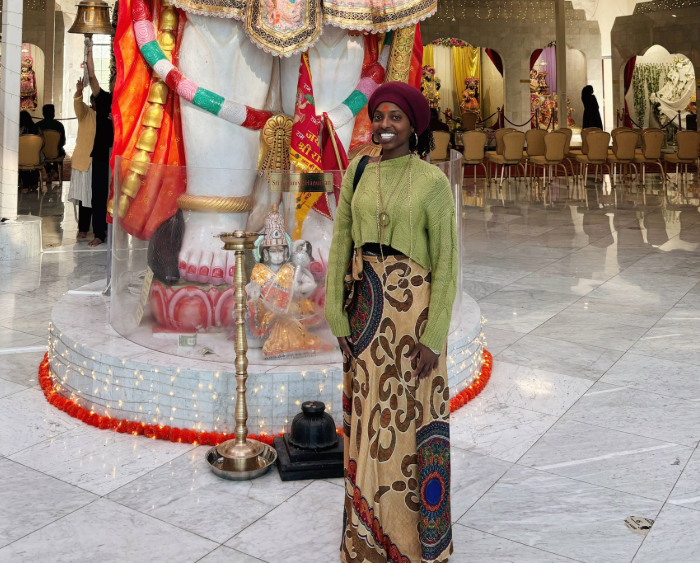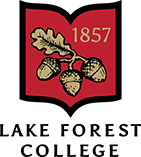Tracy Wamarema ’28 films documentary through Richter Scholar Program

As an international first-year student from Kenya, participating in the Richter Scholar Program was a cocktail of “firsts”: my first summer in America, my first interaction with Hindu culture, and my first real taste of independent fieldwork.
Having lived in the US for almost a year now, I considered myself fairly acquainted with the home of the brave. But how can you know a place without learning its culture? And how do you learn a culture if not through its people?
The Richter Scholar Program helped me gain a firmer understanding of both.
Beginning a documentary
When I first read Assistant Professor of Religion Anya Golovkova’s project title, “Exploring Hindu Spaces in Chicagoland,” I knew from the name alone that this was something I wanted to be a part of.
The brief outlined the project as a collection of “short background video presentations” about Hindu temples in and around Chicago. That phrase sparked an idea in me—what if we turned these individual pieces into a single, cohesive documentary about Hinduism in Chicagoland?
On one hand, filming a documentary would allow me to indulge my passions in both journalism and film, but on the other, neither of us had filmed a documentary before.

Still, my research partner Andrea Davis '28 and I agreed it was worth pursuing. Our first meeting was a brainstorming session in Buchanan Hall where Professor Golovkova convinced us that we were more than capable of executing our ideas independently. Who knew all it took was encouragement?
Gaining hands-on research experience
With a pep in our step, we organized a camera kit from the library and prepared to visit our first temple: the Hanuman Mandir of Greater Chicago.

The biggest challenge going into this project was getting devotees who had come to worship in peace to speak to strangers about their personal relationship with Hinduism—and on camera, no less. Most temples did not allow photography, so we had to request special permission from the presiding priests. Convincing a devotee to speak on camera proved even more difficult.
Two hours in and multiple videos of temple architecture later, I feared the worst. No one seemed approachable and just when I thought I could speak to the priest, he started the puja ceremony. Afterwards, we headed into a hall where Professor Golovkova told me that dinner was being served. Prasada, she explained, is food that has been offered to the deities before being shared with the devotees. I was impressed. I grew up Catholic— we don’t do free lunch after Mass.
“It’s a gift. They’re giving us a gift,” Professor Golovkova explained.
That became the first sentence recorded for our documentary, the first domino to start it all.

As we partook in this gift, two women approached to compliment my outfit: bright green sweater, Ankara skirt, crimson headscarf—the closest I could come to traditional attire. I saw an opening, and I took it.
“Could I interview either of you for my documentary about Hinduism?”
They said no—but offered up someone else: a younger woman who had in fact helped prepare the puja. Just like that, I got my first real interview.
The following temple visits followed a similar pattern of success and before long, we went from having no interviews to having too many. Each voice had something unique to offer, so deciding what to cut proved difficult. Suddenly, our project seemed too ambitious for the allocated presentation time. With over 60 minutes of footage from five temples and still more to visit, a documentary under fifteen minutes did not seem feasible. Midway through, we had a choice: pivot to a simpler format like a slideshow presentation or commit fully to the documentary and trust the process. It was daunting—but the best things usually are.

The first draft ran long, but it fueled our belief that it would all work out. As it turns out, it did. The final documentary was twelve minutes long, and we proudly premiered it at the Richter Option I symposium on June 6. We are working on a longer documentary to display at the student symposium in Spring 2026.

A deepening appreciation for different ways of life
As Andrea said in our documentary’s closing, “The whole point of the college experience is being open to other mindsets, other ideologies, other people.”
Before this project, I hadn’t realized just how little I knew about Hinduism. Many of the interviewees helped bridge that gap by drawing thoughtful parallels to Christianity—“The Bhagavad Gita is like the Bible,” one devotee told me. It was not lost on me that while they were familiar with aspects of my faith, I was only beginning to learn about theirs.

All the stories behind Hindu practices were rich with cultural weight. I was especially struck by arati, a ceremony where devotees pass a candle over the face of a deity while chanting. The temple architect explained that in India, many shrines are built without lighting. Arati becomes a way to truly see the deities, to illuminate their faces—physically and spiritually.
As we pieced together the footage, one of the most powerful threads running through the documentary was the idea that Hinduism, despite its multitude of deities, believes in a single divine essence. God is one, expressed in many forms. This ultimate reality is called Brahman—the source through which all creation flows. And isn’t that, in a way, similar to the Christian belief in one God expressed through the Holy Trinity?
Echoing this sentiment of oneness, a devotee at the Balaji Temple said, “All religions are giving you some instructions with the same meaning: be kind, be loving, be good.”
That message stayed with me. Across different places and practices, what I witnessed was a communal devotion to something greater than ourselves.
A student-researcher’s lifestyle
This project worked because we were in an environment that supported us. From the nearby Metra to a flexible summer job to a roommate who doubled as my teammate, I was surrounded by resources. Serving on the Richter Planning Committee also gave me insight into the behind-the-scenes logistics that shaped our trips.

This is what a liberal arts education looks like in action. I joined a project in an unfamiliar subject— armed with one Buddhism course and a boatload of enthusiasm. Andrea brought knowledge from REL 214, and I brought my journalism training. With Professor Golovkova’s guidance, we created a documentary exploring Hinduism in Chicagoland.
Due to this project and how much I enjoyed filming, I am registering for CINE 202: Documentary Filmmaking in the fall. I never thought I’d take a documentary class, but experience is a sneaky teacher.
Through the Richter program, I didn’t just flex my journalism muscles—I stretched them. I got to see what it’s like to chase a story, to build trust with strangers, to translate culture into visuals, and to make something that means something.


